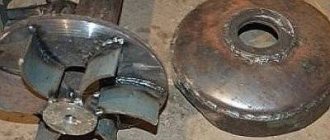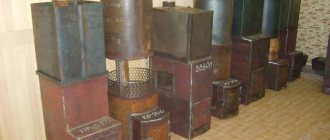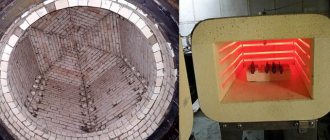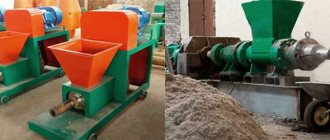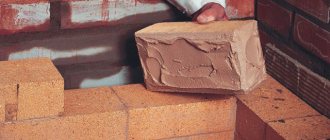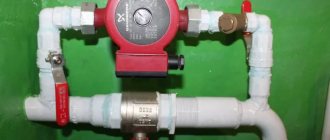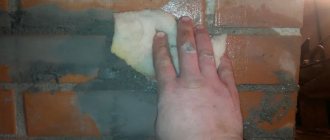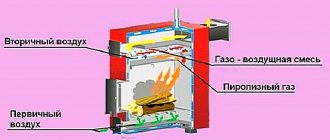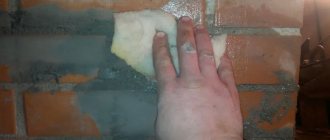Progress of work on installing a stove valve in a brick chimney.
- Let's try the valve “on the ground”.
- We cut out recesses in the brick for a more precise fit of the valve frame.
- We install bricks with cuts on the chimney.
- We install the valve.
- We measure the bricks of the row above the valve. We cut out recesses in the brick for more precise fit and pressing of the valve frame.
- We install bricks with cuts on the chimney, clamping them onto the valve frame.
1.Try on the valve.
Standard valves are designed for 250*120 bricks and a joint size of 10 mm.
In fact, often the brick is smaller and the seams are thinner.
Therefore, it is better to play it safe and try everything on in advance.
We prepare a row of bricks on which the valve will lie.
In my case, the frame rested against the lower ribs and did not fit into the channel.
Using a pick, I knocked down the interfering ribs on the inner surface, after which the valve fell into place.
We install the prepared row of bricks on the chimney.
This is ordinary masonry, no different from the masonry of the stove body and chimney.
We place the bricks on the stove masonry mixture.
We install the damper on the chimney.
It is advisable to place a thin layer of kaolin or basalt cardboard under the valve frame.
Due to the high thermal expansion of the metal, a small gap will always form between the frame and the brick.
A thin layer of non-flammable insulation can eliminate this small drawback.
The insulation will prevent the passage of carbon monoxide between the frame and the brick.
We measure and cut out the bricks that we will place above the valve.
This is the most difficult operation in the entire process of installing a furnace valve .
The beauty and reliability of this unit depends on how accurately you can measure and cut out the recesses for the valve frame.
I measure and cut each brick separately, but it is possible to do everything at once.
Here it is important to cut out the slot evenly for the movement of the valve tongue.
This cut will be visible on the outside of the chimney, so you should treat it with special attention.
We install bricks with cuts, pressing the latch frame.
When installing on top of the tongue, I place cardboard.
This is necessary so that the masonry mixture does not get on the tongue.
After installation and hardening of the mixture on the chimney, the cardboard is removed and the tongue moves freely.
Why are there empty seams between the bricks?
I built this stove for further lining with a colored mixture.
Brick hob, no oven. Colored stitching.
Masonry stove mixture and jointing mixture are different materials.
For further high-quality color jointing of the stove and chimney, you need to scrape the seam 1-2 cm deep.
I immediately leave the seam a little unfilled to reduce the work when unstitching.
Furnace valve for furnace - purpose and manufacturing options
The stove valve, or gate valve, is a very important element of any stove. Therefore, if you have a homemade heating system at home, then you should know every little detail and every detail. At this stage it is worth understanding the furnace valve in more detail.
- What is a gate?
- Is a valve needed in a sauna stove?
- Principle of use
- Kinds
- By design
- By material
- How to make a stove valve with your own hands?
- Retractable gate
- Manufacturing of a rotary gate
- How to install?
- Installing the damper in the furnace
- Pipe installation
- How much does it cost in stores?
- Conclusion
Let’s take a closer look at why a furnace valve is used.
Which material is stronger
In addition to structural differences, gate valves differ based on the material used at the manufacturing stage. The only available solution is stainless steel. This is due to the fact that it does not deform under the influence of high temperatures, and also retains its original appearance and characteristics even after several years of active use.
Valves in stainless steel gate valves from the manufacturer Ferrum are fixed using argon welding on a rod 8 millimeters long. The presence of a reinforced spring ensures the design's reliability and durability.
Is a valve needed in a sauna stove?
Definitely needed. Good draft in the bathhouse is the key to successful construction of the stove.
According to experts, it all depends on the design of the sauna stove. If there is a chimney, then there is no doubt about the need for a damper. The oven damper is used in all types of ovens. The principle of their operation is a little similar, so you shouldn’t bother. A gate is definitely needed. If combustion is only carried out thanks to the supply air, the valve is not installed. The gate will help you save on fuel, getting the most out of every run. The fuel will not be wasted.
Principle of use
The main thing is to choose the right device for your stove and learn how to use it (even though it is very simple). An important nuance is that when the furnace is idle for a long time, you must keep the damper closed to avoid foreign elements getting in there.
The damper also separates the insulated part of the chimney from the non-insulated part. The gate is usually installed at the beginning of the pipe. At the end where the pipes are well insulated, installing a valve is not recommended.
What functions of the damper have we derived?
- With its help, traction is adjusted.
- It protects the chimney from temperature changes.
Despite the simplicity of the design, there are different valves. The design, material and dimensions of furnace valves play a role.
By design
- Retractable. This type of plug is the most convenient. It is a chimney nozzle with a retractable plate in the middle. It is this plate that moves freely in the grooves of the chimney. This type of damper is most often used in brick stoves. But it can be installed on others. This design is easy to install and does not require installation costs.
Round furnace valve or view
A round-shaped stove valve is otherwise called a view. This is a special valve with a slightly different design than the regular version.
The view consists of the following parts:
- The housing is in the form of a plate, which can be round or square with a round hole.
- A shut-off element in the form of a disk that closes the hole and blocks air exchange in the pipe.
- The control part, in the form of a regular handle in the center of the disc valve.
You cannot use a view to control air exchange, since you need to remove the damper from the air passage manually, which is almost impossible in a heated stove, in addition to exhaust gases. The design is used exclusively as a locking element, often as an additional damper for a complete result before igniting the stove and after it goes out.
It is recommended to install both types of cast iron stove valves far from the firebox.
How to make a stove valve with your own hands?
Do-it-yourself stove chimney valve is not a problem. At home, having a grinder, a welding machine and the necessary material, you can assemble both a retractable and a throttle gate. It is very important in such a matter to maintain the accuracy of calculations. It is necessary that the valve fits perfectly into the groove and can move freely there.
Retractable gate
There is nothing complicated here. The retractable gate is a retractable frame and the base itself.
- The chimney damper for a stove with a sliding frame requires the most accurate measurements. First you need to calculate the cross section inside the pipe.
- Next, based on these measurements, a frame is cut out (most often a steel sheet is taken) that will extend. A bend is made at its end for more convenient control. All ends should be carefully cleaned so that there are no unnecessary irregularities.
- Depending on the chimney, a steel sheet, strip or wire is used for the frame. But there is a method for a round chimney. Use two identical sheets of metal (thickness - 2 mm) and cut two holes in the middle according to the diameter of the pipe. The plate that will fit into the frame is cut out separately.
- Next, you need to weld the structure so that the holes for the pipe match. Between the sheets you need to leave 4-6 mm of free space.
Video instructions for making a retractable stove valve for a metal chimney:
Manufacturing of a rotary gate
For a rotary valve you will need a steel angle (30 by 30) and sheet steel 2 meters thick.
- First, measure the chimney and make a frame from the corner using these measurements.
- We cut out the part according to the measurements and try it on the pipe.
- We take a piece of pipe with internal thread and place it in the center of the workpiece. We make marks so that the edges of the pipe are 3 mm shorter than the valve itself.
- Cut off all excess.
- We make 3 holes on the valve blank and weld the pipe to them.
- The structure is ready (the installation process is described below (after the brick version).
A homemade valve in a chimney has a right to exist. The only thing is that this matter can take a lot of time due to the number of precise measurements.
Useful video instructions for making a rotary gate:
Making a rotary gate yourself
Damper installation option
When using a chimney, it may be necessary to replace the damper, and a standard damper is not suitable for this design. In this case, the damper is made independently according to the dimensions of the pipe.
To work you will need metal scissors, a drill, a grinder and a welding machine.
- A frame for the damper is welded from steel corners with a flange size of 35–45 mm. The size of the parts corresponds to the diameter of the pipe.
- Holes are drilled in the frame to secure the axle. For a gate with straight rotation, they are located in the horizontal plane, and for an angular one, they are located diagonally.
- Bushings are welded from two sections of half-inch pipe, which ensure rotation of the axis.
- The damper is cut to the size of the frame; the material is a steel sheet 2–3 mm thick.
- An axis on which the damper will be mounted is inserted into the holes in the frame. The second part of the metal piece will become the adjustment knob.
- The plate is inserted into the frame and fixed to the axis by welding.
- For safe use, there must be a 1mm gap between the flap and the frame.
- To ensure the plate is fixed in the open state, a limiter is installed.
Drawing of a rotary gate valve
Note! The choice of damper model depends on the design of the chimney and the type of heating system, but its installation is mandatory. The device allows you to regulate the draft level and keep the heating system in working condition.
How to install?
How to properly install a valve on a stove and how to install a valve on a chimney? It's simple, let's consider 2 cases.
Installing the damper in the furnace
When installing the damper in the furnace, you need to take into account that this is done during brick laying. It is placed at the beginning of the pipe, about a meter from the surface of the furnace itself. The frame fits tightly into the chimney structure, and the damper is installed after.
Installing a valve in a furnace can be done in three steps:
- Reach the 6th row of brick laying.
- Apply the solution in the desired location and carefully install the frame there. Sometimes you need to cut grooves in the brick for convenience and easier retraction.
- Align the frame so that it lines up with the bricks. Then you can continue laying bricks.
All cracks that may form when installing the plug must be sealed with mortar. Otherwise, there will be loss of thrust and combustion.
Pipe installation
The damper is also installed at a height of 1 meter from the firebox. It is important that this is the uninsulated part of the pipe. Then there will be no temperature difference when the valve operates.
Installation on the pipe is also simple. First, the first part of the pipe is attached. The joints are lubricated with sealant (temperature-resistant). A gate is tightly placed on top of the structure (the first nozzle). The second part of the pipe is attached to the gate on top. This entire structure is connected to an insulated chimney.
Thus, there is no need to further secure the structure.
It is worth saying that homemade gates can be attached to the pipe a little differently. This already depends on the design. An example of installation of a homemade rotary gate, we reviewed the manufacturing instructions above:
- We make a mark on the chimney pipe.
- Let's try on our preparation.
- We insert the gate into the pipe and screw it into the structure with a thread.
Types of gate
Retractable
The retractable type gate is considered the most convenient and reliable to use. This is a smooth plate with a small longitudinal hole that moves along grooves in the chimney. It is mounted in a horizontal position, the traction force is regulated by the movement of the plate, which reduces or increases the cross-section of the pipe. This type of valve is intended for brick stoves, although it can also be used in chimneys made of steel pipes.
Gate with plate
Prices for retractable gate
Rotary (throttle)
Rotary gate. The plate that regulates traction is visible
The rotary gate is a metal plate with a guide welded in the center. It is installed inside the chimney, with the end of the guide necessarily leading out. The traction is adjusted by rotating the plate around its axis. This design is less reliable, since over time the welding fastening weakens and the damper comes off. The rotary damper is used in steel chimneys.
Installation of furnace equipment
Installation of furnace equipment
It is installed during the process of laying the furnace mass. The grates are installed below the level of the combustion opening on one row of brickwork with a slope of 25-30mm towards the combustion door. The slots between the grates should be directed along the length of the firebox. To ensure that the grate does not destroy the brickwork during thermal expansion, it is laid relative to the brickwork with gaps of at least 5 mm, which are then covered with sand. It is unacceptable to fasten grates using mortar.
Fire door
- one of the weakest links in the brickwork of the furnace. It is installed with a gap of 5 mm around the entire perimeter of the combustion hole. The gap is sealed with an asbestos cord followed by filling with a clay solution with the addition of salt. The combustion door is secured in the brickwork using metal quotes made of sheet steel 3-4 mm thick or a wire, which is attached on four sides to the door frame. The quotes are fixed to the back of the brickwork, and the wire is laid between the bricks and sealed with mortar. In order not to increase the uniformity of the masonry, the fire door was installed so that its top row coincided with the horizontal seam.
Blower door
attached in the same sequence. So that it is less affected by high temperatures, it is installed without a gap.
Oven
installed so that it is blown from all sides by hot gases. On the firebox side, the oven is lined with brick on edge, and coated with clay mortar on top. They fix it in the same way as the door, filling the gaps with asbestos cord and mortar.
How is traction adjusted?
Adjustment is the most important aspect of operating furnace equipment. With proper control of this process, you can achieve the highest efficiency from the device, as well as save the health of the residents of the house. Even if the partition is completely blocked, there is still a gap for the movement of exhaust gases. It must be closed exclusively in the final part of the firebox (after the wood has finished burning and an ash layer has formed on it). According to fire safety requirements, the damper must have a small hole through which weak gas exchange occurs.
Considering the importance of this element, it is necessary to choose trusted manufacturers. Such as the manufacturing company Ferrum.
About the stove valve: fine-tuning and how to make a hole in accordance with the standards so as not to “burn out”
One of the most important components in the furnace is the valve of the main chimney, installed in front of the chimney after the smoke channels of the convective system of the brick furnace have ended. Today there is a wide variety of their designs on the market; rotary, overseas ones have also appeared, which are rightfully liked by many users. However, the classic of domestic production does not go out of fashion - the most common type of cast iron valve, consisting of a frame and a “tongue”. In the photo you will immediately recognize it, a timeless model, it is present in most stoves and is familiar to everyone since childhood. Stove-makers who repair stoves also sometimes encounter problems such as jammed valves, which is typical for old stoves. This is also an excellent reason not only to change it, but also to modify it wisely, as they say.
Despite all the refinement and extreme simplicity of its design, which has not changed for decades, it can also be modified, and sometimes it is even necessary. Today I will not consider the case when it is located deep in the furnace mass (body), but will talk about a small modification when it is installed in close proximity to the smoke duct - at the beginning of the chimney. In the photograph, the beginning of the pipe has a cross-section - the so-called “five” - of one whole brick: 250 x 120 (without taking into account the thickness of the masonry joints). Sometimes stove makers put a lock on the tongue to prevent the user from accidentally removing it - this is reasonable when it is located deep in the masonry, but in my purely subjective opinion, it is unnecessary in the latter option. However, in order for the owner to understand to what extent it needs to be pulled out and at the same time understand that the chimney chimney smoke channel is completely open, you can, after marking it in advance, drill a hole in it, which will visually make it clear that the channel is completely open. The hole is clearly visible in the photograph. By the way, in this way, another problem is solved - according to current safety requirements, in order to prevent carbon monoxide poisoning in chimney valves, a hole of a certain cross-section must be provided, which is not available when the fittings are supplied by the factory. Often, stove makers simply cut off a small corner at the end of the valve tongue and do exactly the right thing, but do not solve the problem, the solution to which I proposed above.
The size of this hole , according to the currently valid Code of Rules 7.13130.2013, is defined in paragraph 5.9. at least 15 x 15 mm . The shape of the section is not specified, although it is clear from the indicated dimensions that it is a square. It is also obvious that it is not forbidden to make it in a round shape - simply drill the tongue. You can determine the equivalent diameter for selecting a drill using elementary formulas known from school.
Additionally, you can offer a simple mnemonic device - you see a hole on the valve, the hole is like the letter “O” - which means “Open” - the smoke channel of the pipe is completely open. We pushed the valve in as far as it would go - the channel was closed, and the oven could not cool down. They are afraid that the stove will dry out because of this hole. They also should not, since it is too small and when the flue gases are still quite hot after the end of combustion, the effect of blocking the small holes occurs due to the increased viscosity of the heated gases. This is a well-known physical effect, which was also mentioned by one of the leading companies, a manufacturer of metal furnaces, when reviewing and criticizing “Buleryan” type structures - around the walls of the firebox there are convective tubes designed to serve for more intense heat exchange between the walls of the furnace and the surrounding air of the room. This mode of operation of the furnace was questioned based on the analysis of furnace processes using numerical mathematical modeling methods in special software environments.
If you liked my proposal for modification, you can implement it by removing the tongue and drilling a hole in it with a metal drill according to the previously made markings. Cast iron is quite easy to machine (although there are exceptions, apparently it has to do with the specific formulation of a particular charge at the enterprise), this improvement will not take much effort and time from you. However, if you wish, no matter where you are - be it in the most remote corners of the Moscow region, or in the center of New Moscow, you can invite a stove maker to perform this and other work on tuning your stove.
PS If you were looking for information on how to insert a valve into a stove, then the best answer and solution to this issue would be to contact a professional stove maker.
PPS If you are really looking for a professional stove maker, then I recommend that you familiarize yourself with this section of the site: stove laying
In order to install the valve, it is best to prepare the bricks in advance by marking them and sawing the necessary openings or grooves if necessary.
Design of a furnace valve and its installation in a pipe
A stove valve is an integral part of any stove, the role of which is to regulate the draft in the chimney when the stove is already flooded and at the end of the fire in order to disconnect the stove from the chimney, as well as to switch the chimneys in combined stoves. The product consists of a frame and a slider. It performs its function by moving the slider in the grooves of the frame, as a result of which the cross-sectional area of the inlet of the chimney changes. This leads to a decrease or increase in vacuum.
In order to close the pipe as tightly as possible after flooding, it is recommended to install two valves, one on top of the other.
Furnace valve design
The furnace valve is a structure consisting of three parts:
- Cast iron body - frame (sometimes steel is used instead of cast iron) with side grooves.
- The locking part is in the form of a panel damper, thanks to the movement along the grooves of which the sealing of the chimney is controlled.
- The control part on the panel damper is in the form of a handle. This makes it easy to operate the panel damper manually.
The shape of the valve must completely coincide with the shape of the chimney; according to this parameter, they can be rectangular, square, or round.
A few words about rectangular valves
A rectangular valve can be of various sizes from small to very large, when the length of the valve reaches up to 600 mm. Large options are usually suitable for Russian stove chimneys, fireplaces, barbecues, etc. The purpose of the design is the same - to block the flow in the air ducts.
The smallest furnace valve has dimensions of 13x13 cm, and the largest is determined according to the individual requirements of the consumer. The most popular size for these structures is 26x13 cm, since these are the dimensions of the chimney of an ordinary Russian stove.
Thanks to square or rectangular stove valves, you can not only stop the air exchange in the pipe, but also adjust the intensity of the fire by changing the chimney draft and throughput. For this purpose, simply close the damper not completely, and then gradually pull the handle towards you, thereby controlling uniform combustion in the firebox.
Round furnace valve or view
A round-shaped stove valve is otherwise called a view. This is a special valve with a slightly different design than the regular version.
The view consists of the following parts:
- The housing is in the form of a plate, which can be round or square with a round hole.
- A shut-off element in the form of a disk that closes the hole and blocks air exchange in the pipe.
- The control part, in the form of a regular handle in the center of the disc valve.
You cannot use a view to control air exchange, since you need to remove the damper from the air passage manually, which is almost impossible in a heated stove, in addition to exhaust gases. The design is used exclusively as a locking element, often as an additional damper for a complete result before igniting the stove and after it goes out.
It is recommended to install both types of cast iron stove valves far from the firebox.
How to close a furnace valve, operating rules
The operation of the furnace valve itself is quite simple, but it is definitely associated with some risks that threaten human health. If you close the structure in a stove that is still burning or if the fuel is not completely burned, then exhaust products can enter the room, poisoning the air.
Therefore, the use of a valve, which allows you to save heat in the furnace for longer, should be used extremely wisely, that is, the structure should be closed on time. It is known that due to the cast iron valve, the heat in the stove and, accordingly, in the room remains for a long time. The use of fuel such as coal increases the temperature inside the furnace by approximately 60-700C.
Sometimes, in order to save fuel, the valve is closed earlier, before it is completely burned, which is extremely undesirable. After all, human health and life are higher than any savings. Closing the damper earlier than necessary increases the risk of carbon monoxide poisoning. Carbon monoxide is a combustion product that is poisonous. Therefore, to avoid such situations, you need to use the chimney valve correctly, following some rules:
- Before closing, be sure to stir the coals to avoid the presence of completely unburnt pieces.
- During the initial attenuation of the coal, when the blue flame is no longer visible on the surface, the damper should be slightly closed, but it is not recommended to close it completely. After all, the presence of coals does not mean that they are completely burned out. If there is a need to seal the pipe, this should be done after complete combustion of the coals.
- Next, you need to open the ashpit so that a draft is formed, and the remaining coals are completely turned into ash and ash.
The need for valves and views in the chimney
The damper is an integral part of the stove, which closes the chimney after it is fired. In combined stoves, such as cooking and heating stoves, this design allows you to move between smoke exhaust channels.
The damper is usually installed in the chimney when laying the stove, secured with several rows of bricks. Often two valves are installed, especially in rooms in cold climates, when temperature changes are more significant, which leads to rapid heat exchange.
The view is installed in the chimney in the same way, but is usually used in Russian stoves. This valve is closed from the outside using a special door. If it is necessary to ventilate and cool the oven, all this can be done with the view door closed.
The design of the stove view makes it possible to eliminate the installation of an additional valve, because it completely copes with sealing the smoke exhaust pipe. When using the second valve, it is installed below the view.
How to install a valve on a chimney
The valve is usually installed during the construction and assembly of the stove. The process is carried out in several stages:
- Laying bricks around the fittings in a selected location at a certain stage of chimney construction. In this case, the dimensions of the hole left must completely coincide with the dimensions of the valve. Often, wire is installed in the corners of the body, mounting it into the body of the masonry.
- Installation of the valve frame with fixation of the upper part using cement mortar.
- Applying cement mortar around the perimeter of the frame and wire about 1 cm thick, followed by laying a row of bricks.
- Installing a damper in the chimney.
A conventional cast-iron stove valve is locked with a panel damper, which is mounted in the frame body through a slot. It can be installed after mounting the frame. The damper on the view is closed manually, so a special door needs to be installed above the body of this design, with which you can control the lid.
After this, installation of the chimney continues accordingly.
Summer flap and its meaning
Often in stoves there is such an element as a summer damper, which has a specific purpose. The summer damper is used in fireplaces or Russian stoves, which are heated irregularly or periodically at long intervals. For example, in stoves in a country house or village house, when it is heated only in the summer season.
The summer valve has some design features and a special location, which makes the combustion process much easier after prolonged cooling, even in the most severe weather conditions.
The operation of this design is carried out in this way: The stove must be lit with the summer valve open, then, when the flame in the firebox flares up and some of the firewood has completely burned out, the valve must be closed to prevent heat loss.
Stoves with a summer damper installed in them have a number of advantages, for example, by pulling out the summer damper and ash pan, you can use the stove at any time of the year as a classic open fireplace. With the help of a damper you can easily get rid of excess heat in the room. However, it should be remembered that it is recommended to heat such a stove for no more than 20 minutes, since the temperature can rise significantly, which is a feature of such fireplaces.
Why do you need a chimney damper - what is a damper, types, installation rules
A damper is a damper, a valve for a stove chimney, designed to improve draft in it. This part is made of metal. It is installed at the stage of construction of the chimney pipe and ventilation passage.
Draft is of great importance for the functioning of the heating unit. When it is strong enough, the fuel burns completely, resulting in reduced costs. When the draft is poor, a fire can occur at any moment, and to prevent this, install a damper for the stove or fireplace.
The valve prevents the division of mechanical inclusions released during fuel combustion, which are gas bubbles and particles. Due to this property of the gate, it is used when heating a room with gas, coal, oil products, etc.
Functional purpose of the gate
To understand the purpose of this part for the chimney structure, you need to understand what a damper in a stove is. The damper provides a change in the traction force in the unit by adjusting the combustion of fuel in the firebox.
This element has an important advantage - it has low resistance relative to the remaining gas bubbles, which must be removed outside the room. When the chimney is inoperative, then the damper is completely closed.
The gate has a significant drawback - sometimes its welding burns out. This problem occurs quite often - its cause is usually a neglectful attitude towards the quality of this product on the part of manufacturing companies.
Summer flap and its meaning
Often in stoves there is such an element as a summer damper, which has a specific purpose. The summer damper is used in fireplaces or Russian stoves, which are heated irregularly or periodically at long intervals. For example, in stoves in a country house or village house, when it is heated only in the summer season.
The summer valve has some design features and a special location, which makes the combustion process much easier after prolonged cooling, even in the most severe weather conditions.
The operation of this design is carried out in this way: The stove must be lit with the summer valve open, then, when the flame in the firebox flares up and some of the firewood has completely burned out, the valve must be closed to prevent heat loss.
Stoves with a summer damper installed in them have a number of advantages, for example, by pulling out the summer damper and ash pan, you can use the stove at any time of the year as a classic open fireplace. With the help of a damper you can easily get rid of excess heat in the room. However, it should be remembered that it is recommended to heat such a stove for no more than 20 minutes, since the temperature can rise significantly, which is a feature of such fireplaces.
Technical characteristics of the gate
For the manufacture of gate valves for stoves and fireplaces, stainless steel is most often used - steel that is least susceptible to corrosion processes. The thickness of the metal should be one millimeter.
The surface of the part is ground to an absolute smoothness, which has no defects, so that it can be easily cleaned from dirt and soot deposits that accumulate over time. This circumstance contributes to the appearance of good draft in the chimney pipe, since there is no resistance to the exit of gas particles.
The damper for the unit can withstand high temperatures - up to 1000 degrees. Due to the fact that the part is made of stainless steel, carbon monoxide is better removed from the ventilation or chimney. The shiber is not at risk from temperature changes.
Why do you need a valve?
Using a damper allows you to close the chimney channel after using the stove.
The holes in this device prevent complete blockage of the cross-section of the smoke exhaust channel. It is worth remembering that the closed position of such a valve indicates that the chimney is not in use, and the open position means the start of the firebox. The draft in the chimney is a very important indicator that determines not only the efficiency of removing combustion products from the chimney, but also the efficiency of the heating system as a whole. Therefore, traction control, carried out using a slide element, is very important. If the level of thrust in the system exceeds the permissible parameters, it is necessary to adjust the position of the gate element. This valve regulates draft by decreasing or increasing the cross-sectional area of the smoke exhaust channel.
In addition, the gate elements perform another important function, which is to regulate the combustion of products in the heating device. The intensity of combustion is controlled due to the fact that such an element regulates the movement of air flow within the system. It is worth noting that gate products cannot be installed if heating raw materials are processed in the device due to supply air flows.
The most durable and easiest to maintain are stainless or galvanized valves.
As a rule, such products are made of stainless steel, which has good strength characteristics. Stainless steel is resistant to destructive corrosive effects, and is also resistant to active chemical compounds formed inside the chimney. The thickness of the gate varies from 0.5 to 1 mm. The gates have high thermal stability and can withstand temperatures up to 900 degrees Celsius.
Helpful information! It is recommended to select dampers with a polished surface. A polished damper is easier to use and easier to clean from soot.
The damper has rolling seams and is capable of covering a fairly large area of the smoke exhaust channel (up to 85 percent). Such characteristics have made this product very popular among consumers.
Types of gate valves
The valve for a fireplace or stove comes in several types:
- Retractable horizontal installation . In this case, there is a plate inside the gate that extends, as a result of which the cross-sectional size of the ventilation or chimney pipes changes. This type of damper is used when installing brick chimneys; they are distinguished by their horizontal arrangement. The plate has special small holes - even in the closed position they do not completely block the air duct. This feature allows you to avoid future fires.
- Classic butterfly valve . Such a damper operates due to rotational movement inside the air duct. Such a gate installation consists of a metal body and a removable rotating disk. If used for a long time, it may become faulty, but replacing the part will not be difficult. You can perform this procedure on your own. Even in the absence of certain skills, you can do the entire design of a classic-type throttle installation with your own hands. This type of gate valve is easy to use and does not require constant monitoring by the property owner.
- Air gate valve for chimney . Refers to control parts that control the amount of fuel in the combustion chamber. Workflow management is carried out automatically.
Advantages of gate valves
Gate valves, which make up a significant part of the range of many manufacturers of pipeline fittings, have a number of advantages, the most significant of which are given below in the form of short abstracts.
- Gate valves have a short overall length, for example, compared to cranes.
- The design of a gate valve is relatively simple, which, on the one hand, determines its ease of installation (for example, the possibility of replacement without cutting into a pipeline) and ease of operation, and on the other hand, reliability.
- Reliability indicators largely depend on the parameters of the working environment ─ its aggressiveness, temperature, concentration of mechanical impurities.
- Gate valves are unpretentious and not capricious equipment; their maintenance and repair do not require very highly qualified personnel.
- Gate valves from the best manufacturers, who use high-quality components and modern materials in their manufacture, have such important properties as durability, resistance to wear and exposure to aggressive environments.
- The service life of gate valves can be measured at three or more decades, determined by the service life of the body. For other components it is smaller, but also very impressive. For example, for rubber products - at least 5 years. The same is the average service life between major repairs of a gate valve.
- The absence of stagnant zones and the ability to self-clean allow you not to think about slag and dirt.
- An important parameter is the minimum hydraulic resistance of the medium. For example, gate valves manufactured by ARMATEK have a coefficient of hydraulic resistance of no more than 0.3 when the blade is fully open.
- Gate valves have unique technical capabilities, including fast operation and high tightness. Including tightness of the highest class A according to GOST R 54808-2011. Pipeline fittings. Standards for tightness of valves."
Technical parameters and a wide range of functionality ─ a range of sizes, pressures and temperatures that meet all needs ─ make gate valves truly universal pipeline fittings, in demand in a wide variety of technology areas.
DIY chimney damper installation
You can install a damper for a fireplace or heating unit in one of three ways:
- The damper is installed directly in the fireplace insert. It is placed at a distance of 100 centimeters from the heating device, which makes it easy to control.
- Combining the damper with other elements of the heating structure without the use of additional fasteners. This installation method is called “pipe to pipe”.
- The damper is installed in ventilation pipes. It is used to prevent the fan motor from overheating during operation.
Installation must be carried out in the closed position of the gate to prevent excess load on the engine.
Since there are a variety of models of stove units and fireplaces and heating using them is carried out in different ways, each of them requires its own type of valve.
For example, for a stove operating on gas, you will need a classic rotary-type throttle valve or a rotary automatic damper, since they are capable of blocking the chimney pipe completely and then the flame will not be able to escape outside.
At the same time, rotary valves should not be installed when installing a sauna stove, since when closed they will allow steam to pass through, and in the open position they are very difficult to clean.
As a rule, a damper for a fireplace or stove unit is sold as a complete set along with a chimney. But there are smoke exhaust structures without a damper, so you can make one yourself by buying elements for it at a hardware store. The main thing to do before purchasing them is to decide on the required sizes.
It is better to buy valves made from stainless steel. The main part of the gate installation is the shell. The gate contains several shells.
The need for valves and views in the chimney
The damper is an integral part of the stove, which closes the chimney after it is fired. In combined stoves, such as cooking and heating stoves, this design allows you to move between smoke exhaust channels.
The damper is usually installed in the chimney when laying the stove, secured with several rows of bricks. Often two valves are installed, especially in rooms in cold climates, when temperature changes are more significant, which leads to rapid heat exchange.
The view is installed in the chimney in the same way, but is usually used in Russian stoves. This valve is closed from the outside using a special door. If it is necessary to ventilate and cool the oven, all this can be done with the view door closed.
The design of the stove view makes it possible to eliminate the installation of an additional valve, because it completely copes with sealing the smoke exhaust pipe. When using the second valve, it is installed below the view.
